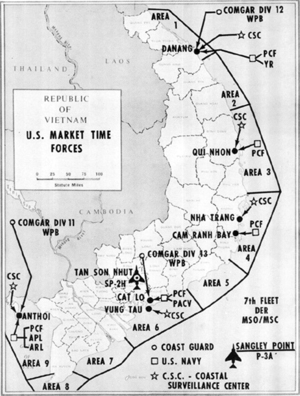Market Time
| Operation Market Time | |||||
|---|---|---|---|---|---|
 |
|||||
|
|||||
| Belligerents | |||||
|
|
|
||||
Operation Market Time was the United States Navy and South Vietnam’s successful effort to stop the flow of troops, war material, and supplies by sea, coast, and rivers, from North Vietnam into parts of South Vietnam during the Vietnam War. Also participating in Operation Market Time were United States Coast Guard Squadron One and Squadron Three. The Coast Guard provided heavily armed 82-foot (25 m) patrol boats and large cutters that included 5" cannons used in battle and gunfire support.
DER's, based in Pearl Harbor, provided long-term presence at sea offshore to guard against trawler infiltration. Originally built for WWII convoy duty, and then modified for DEW duty in the North Atlantic, their sea keeping capability made them ideal for long-term presence offshore where they provided support for SWIFT boats, pilot rescue and sampan inspection. There were two or three on station at all times. Deployments were seven-months duration, with a four- or five-month turn-around in Pearl. When off station, they alternated duty as Taiwan Defense Patrol, with stops in Subic and Sasebo for refit mid-deployment.
Operation Market Time was one of six Navy duties begun after the Tonkin Gulf Incident, along with Operation Sea Dragon, Operation Sealords, Yankee Station, PIRAZ, and naval gunfire support.
When a trawler was intercepted landing arms and ammunition at Vung Ro Bay in northern Khánh Hòa Province on 16 February 1965. it provided the first tangible evidence of the North Vietnamese supply operation. This became known as the Vung Ro Bay Incident. Operation Market Time was established by the United States Joint Chiefs of Staff at the request of General William C. Westmoreland, commanding general of Military Assistance Command Vietnam. He requested that the U.S. Navy establish a naval blockade of the vast South Vietnam coastline against North Vietnamese gun-running trawlers. The trawlers, usually 100-foot-long Chinese-built steel-hulled coastal freighters, could carry several tons of arms and ammunition in their hulls. Not flying a national ensign that would identify them, the ships would maneuver “innocently” out in the South China Sea, waiting for the cover of darkness to make high-speed runs to the South Vietnam coastline. If successful, the ships would off load their cargoes to waiting Việt Cộng or North Vietnamese forces.
...
Wikipedia
